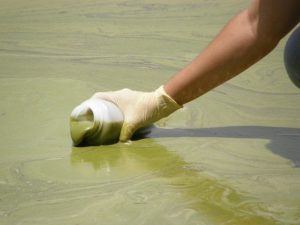
High tech metal particles may inadvertently take a toll on aquatic life
The last 10 years have seen a surge in the use of tiny substances called nanomaterials in agrochemicals like pesticides and fungicides. The idea is to provide more disease protection and better yields for crops, while decreasing the amount of toxins sprayed on agricultural fields. But when combined with nutrient runoff from fertilized cropland and manure-filled pastures, these “nanopesticides” could also mean more toxic algae outbreaks for nearby streams, lakes and wetlands, a new study finds.
Their nano-scale gives them different chemical and physical properties from their bulk counterparts, including more surface area for reactions and interactions. Those interactions could intensify harmful algal blooms in wetlands, according to experiments led by Marie Simonin, a postdoctoral associate with biology professor Emily Bernhardt at Duke University.
These nutrient-fueled “blooms” eventually reduce oxygen levels to the point where fish and other organisms can’t survive, creating dead zones in the water. Some algal blooms also release toxins that can make pets and people who swallow them sick.
Date: June 25, 2018
Image: Google Images
Coordinator: EnvGuide Team
Source: https://today.duke.edu/2018/06/nanomaterials-could-mean-more-algae-outbreaks-wetlands-waterways